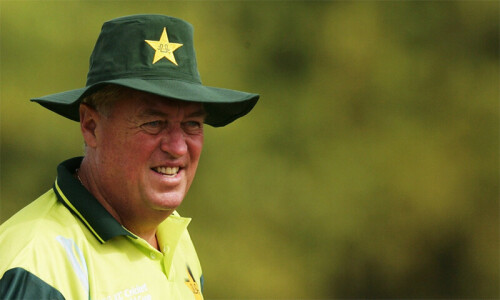 |
| A film on the Karachi Circular Railway by Ivan Sigal shown at Numaish Karachi.—White Star |
KARACHI: Urban open spaces in the city seem to have been hijacked, and instead of being an inclusive space, have become more marginalised than thought possible. Numaish Karachi aims to open up these public spaces for more “cultural production” and allow them to develop a more accepting ambience. With over two dozen installations and artefacts set up in the Frere Hall gardens, the exhibition brings together designers, artists, film-makers, scientists and engineers turning the public space into an interactive place for children and adults.
The exhibition incorporates theatre and art to liven up the space. There are carrom boards at one end, specially designed with a transparent board so that lights may be flashed underneath to allow children to play the game at night. At the other is a make-shift life-size saanp-seerhi, also known as snakes and ladders, with children jumping around playing with fake rubber snakes that are such a significant part of almost every childhood. A chaar-doli wallah jhula, (handcrafted Ferris wheel) fast vanishing from the Karachi landscape, was being painted and buffed. Also known as handola in Urdu and chudail in Sindh, this is “an indigenous form of play in Pakistan”. According to the organisers, it first “surfaced in Karachi in the 1950s with the arrival of the Lucky Irani Circus”.
Designer and curator of Numaish Karachi Saima Zaidi wishes to “activate these public spaces”. She is the author/editor of Mazaar, Bazaar, which charts the trajectory of design and visual culture in Pakistan, and is working for this exhibition with the aim of “highlighting these spaces of the city as places where men, women and children come to relax, play and interact”. Thus the venue has an open-air gallery, theatre, laboratory and playground.
It is not all fun games at Numaish Karachi. One of the most interesting installations is the Kutubkhana, and open-air library by architects Khadija-tul-Kubra and Ilma Wasty. The design of the Kutubkhana is such that is boasts inbuilt seating and book shelves and can accommodate up to 10 adults. Books and newspapers will be part of the library, and the organisers believe it will be a very conducive space “for intimate events such as poetry recitals and book readings”.
Artist Yasir Husain is responsible for the installation “Overview Effect Karachi” which is a light installation made with the help of solar panels, barbed wire and LED lights. Banking on the overview effect experienced by astronauts in space, the installation aims to induce intense feelings of camaraderie and cognition among people, emphasising relationships on earth, regardless of “boundaries, conflicts and differences”.
The electricity-generating windmill by scientists Dr Anzar Khaliq and Dr Oliver Faust harnesses wind energy and is constructed in such a way that it educates people on how such devices can power smaller devices such as mobile phones. The science laboratory displays the pendulum wave and Newton’s cradle that explains Newton’s Third Law in which every action has an equal and opposite reaction.
Seema Nusrat’s tree installation “Bird Forms” displays the sharp decline in the number of migratory birds visiting Pakistan as a result of rapid development and tree-cutting. Made with the help of dried palm leaves, the bird forms form a “reminder of how in urban settings and concrete environments we tend to forget how essential they are for landscapes”. Seema Nusrat’s sandbag labyrinth is also a fascinating display that uses elements commonly used to exclude, specifically for security purposes, and subverts their function. Allowing children to play outside and within the sandbag installation, the artist allows the “space [to] breathe”.
The venue also had screens set up for attendees to view films. Ivan Sigal’s drone footage of Karachi Circular Railway “explores urban and human landscape through video, stills, text and drone footage”.
Although the exhibit has been open since April 6, it will remain at the Frere Hall till April 22, will travel to three other locations and finally wrap up at Machhar Colony, Keamari.
Published in Dawn, April 11th, 2015
On a mobile phone? Get the Dawn Mobile App: Apple Store | Google Play












































Dear visitor, the comments section is undergoing an overhaul and will return soon.